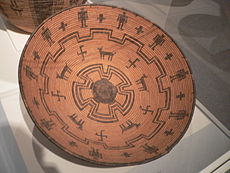Yavapai

An early 20th-century Yavapai basket bowl woven of willow and reed
|
|
| Total population | |
|---|---|
| 1,550 (1992) | |
| Regions with significant populations | |
| Languages | |
| Yavapai (three dialects of Upland Yuman language), English | |
| Religion | |
| Indigenous, Christianity | |
| Related ethnic groups | |
| Havasupai, Hualapai, Mohave, Western Apache |
Yavapai are a Native American tribe in Arizona. Historically, the Yavapai – literally “people of the sun” (from enyaeva “sun” + pai “people”) – were divided into four geographical bands who identified as separate, independent peoples: the Ɖo:lkabaya, or Western Yavapai; the Yavbe', or Northwestern Yavapai; the Guwevkabaya, or Southeastern Yavapai; and the Wi:pukba, or Northeastern Yavapai - Verde Valley Yavapai.
Another Yavapai band, which no longer exists, was the Mađqwadabaya or "Desert People." Its people are believed to have mixed with the Mojave and Quechan peoples. (Several Mohave and Quechan families trace their ancestry to Yavapai roots.) The Yavapai have much in common with their linguistic relatives to the north, the Havasupai and the Hualapai. Often the Yavapai were mistaken as Apache by American settlers, who referred to them as "Mohave-Apache," "Yuma-Apache," or "Tonto-Apache".
Before the 1860s, when settlers began exploring for gold in the area, the Yavapai occupied an area of approximately 20,000 mi² (51800 km²) bordering the San Francisco Peaks to the north, the Pinaleno Mountains and Mazatzal Mountains to the southeast, and the Colorado River to the west, and almost to the Gila River and the Salt River to the south.
Before being confined to reservations, the Yavapai were mainly hunter-gatherers, following an annual round, migrating to different areas to follow the ripening of different edible plants and movement of game. Some tribes supplemented this diet with small-scale cultivation of the "three sisters" – maize, squash, and beans – in fertile streambeds. In particular, the Ɖo:lkabaya, who lived in lands that were less supportive of food gathering, turned to agriculture more than other Yavapai. They had to work to cultivate crops, as their land was also less supportive of agriculture. In turn, Ɖo:lkabaya often traded items such as animal skins, baskets, and agave to Quechan groups for food.
...
Wikipedia
